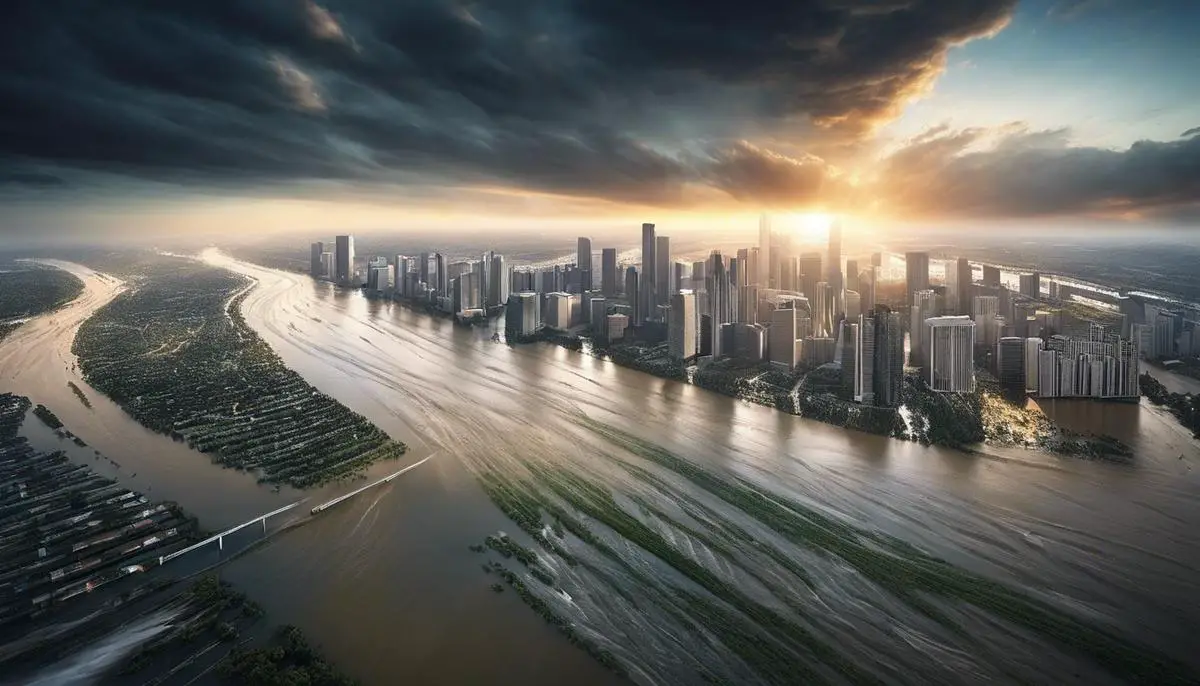When delving into the realm of dreams, floods often emerge as a symbol layered with deep meaning. Rooted both in ancient traditions and contemporary psychoanalysis, the interpretation of floods in dreams taps into the human psyche’s multifaceted depths. These seemingly random occurrences can mirror our emotions, inner turmoil, or fear of impending change, thereby providing introspection and insight into our subconscious mind. This discussion takes us on a journey across Jungian psychology, societal beliefs, prophetic dream analysis, and cutting-edge sleep science to understand the profound and varied interpretations linked to flood dreams.
Symbolic Interpretation of Floods in Dreams
In the vast realm of dream interpretation, water holds a significant importance as an archetypal symbol, with profound connotations. These connotations can be as placid as a quiet brook or as tumultuous as a catastrophic flood, depending on the dream’s context.
A flood, distinguished by its scale and intensity, is not merely a benign representation of water in dream symbology, but instead often implies emotional upheaval or a period of transformative change.
Ubiquitously linked to the oceanic subconscious, a flood in a dream may signify an unanticipated surge of repressed emotions or thoughts. These may be things that have been consciously overlooked or bypassed, yet are forcing their way into awareness, much like a flood breaking through a dam. This could foretell an impending emotional crisis or turmoil that may require immediate attention and resolution for the individual’s wellbeing.
Floods may also symbolize a transformative phase in life. In historical and mythological narratives spanning various civilizations, floods often signal a wipeout or the ending of an era, followed by renewal or the beginning of a new cycle. In a dream state, it’s feasible that the symbolically inundated landscape could be pointing towards a significant and inevitable life change, perhaps an end and a subsequent new beginning.
To interpret a flood in one’s dream, therefore, delves into the complex dynamics between the conscious and subconscious mind as well as the individual’s emotional compass. It stands at the intersection of psychoanalysis, neuroscience, and cultural anthropology, a compelling testament to the intricacies of our cognitive processes. It reconfirms the timeless fascination of academicians and scientists alike with our enigmatic human brain and its richly symbolic dream states.

Cultural and Historical Connotations of Flood-related Dreams
In examining the historical contexts of flood dreams, it is crucial to explore the impact of cultural narratives. Many ancient civilizations, including Mesopotamia, Greece, and India, incorporated flood myths into their respective cosmologies. A well-known example is the biblical story of Noah’s Ark, a narrative present in various forms across multiple cultures, suggesting an occurrence of a great flood. It’s hypothesized that these myths likely stem from collective memories of actual historical flood events, perpetuated and altered over time through oral traditions. Thus, in these cultures, dreaming of a flood may have been considered predictive or reflective of societal anxieties about comparable future events.
Turning our attention to cultural perspectives, we find an intriguing mosaic of interpretations. Many indigenous tribes of North America regard dreams as a bridge between the natural and spiritual worlds. In such cultures, flood dreams could imply communication from higher powers or ancestral spirits, potentially warning of misfortune. Conversely, in modern Western society, driven greatly by impressive strides in psychodynamic theories, such dreams are often viewed through the lens of individual psychology. Hence, a flood can commonly symbolize a sense of being overwhelmed in some area of one’s life, hinging less on societal implications and more on personal introspection.
Lastly, our understanding of flood dreams is incomplete without acknowledging the influence of contemporary environmental anxieties. As climate change propels increasingly frequent and severe flooding events worldwide, the collective human subconscious may well be integrating these experiences into our dream states. This speculation brings us full circle to the era of flood myths, presenting opportunities for an exciting nexus of cultural anthropology, neuroscience, and environmental psychology in future dream research. This is a rather fascinating juncture considering dream symbology – an intersection that warrants profound attention and exploration.

Practical Application and Psychological Implications in Dream Analysis
Flood dreams, particularly, often have practical implications pertaining to the dreamer’s waking life. These flood scenarios, as vivid as they may be, often act as subconscious warnings or revelations concerning overwhelming obligations, responsibilities, or pressures. The sudden surge of water, embodies the notion of an uncontrollable force, thus, they can suggest a sensed inability to control certain factors in one’s life. Such dreams often prompt the dreamer to reconsider their coping mechanisms, reflect on their emotional well-being, and take proactive measures to regain balance and order.
In parallel to their practical implications, flood dreams often induce profound psychological impacts. Jungian psychoanalysis postulates these dreams as indicative of the vast, uncultivated aspects of the collective unconscious – engendered by societal fears, literal or figurative impending disasters, or even global climate anxieties. The flood, in a dream, serves as the tangible manifestation of these nebulous concerns. It forces the dreamer to confront these deeply ingrained, often subconscious, fears – inducing a cognitive dissonance against their otherwise emotionally diluted consciousness.
Evidently, flood dreams serve as an intriguing mirror to both individual and collective anxieties and anticipations. They provide key insights into the dreamer’s subconscious, showcase the power of cultural narratives, and the indubitable influence of environmental burdens on our psyche. The continued exploration of these dream representations, then, unfurls myriad opportunities for fostering a deeper comprehension of the human mind while promoting interdisciplinary intersections between psychology, neuroscience, and environmental studies – a fascinating territory worth comprehensive scientific and academic exploration.

Photo by ulvisafar on Unsplash
Flood Dreams Relevance in Contemporary Sleep and Dream Research
Diving deeper into the realm of dreams, one finds a multitude of connections between flood dreams and current research in sleep and dreaming behavior. Notably, recent advancements in neuroimaging technology have provided novel insights into the ways in which the brain encodes and processes flood dreams. Sleep studies have uncovered that during the Rapid Eye Movement (REM) phase – when individuals dream – brain regions involved in emotion regulation and memory consolidation are particularly active. Consequently, the occurrence of flood dreams during this phase points towards an ongoing process of cognitive emotive discharge, as the mind attempts to reconcile itself with unresolved emotional states.
Furthermore, an intriguing embodiment of flood dreams is their link with a person’s physiological state during sleep. Researchers have discovered intricate interconnections between heart rate fluctuations, body temperature changes, and the thematic content of dreams. It is a fascinating proposition that the inundation symbolized by flood dreams may mirror domestic stressors, triggering specific physiological responses during sleep.
From a broader perspective, the study of flood dreams presents an interdisciplinary collaborative opportunity. The amalgamation of neurobiology, psychology, cultural anthropology, and even climate science can yield comprehensive insights into the intricate workings of the human mind during sleep. Fundamentally, it highlights how our internal neurophysiological processes, psychological states, and external environmental realities intersect to shape the fascinating world of dreams. Moreover, the symbolism of flood dreams, beyond its cultural and historical significance, paves the way for a better understanding of the human psyche’s profound capability to represent complex emotional conditions and anxieties in symbolic, metaphorical forms during sleep.
Ultimately, as science continues to delve into the mysteries of dreams, it is the relentless quest for knowledge that propels the endeavor, reflecting the profound need to understand the human experience in all its facets. As advances in neuroscience and psychology unfold, the interplay between flood dreams and varied realms of human experience will continue to provide valuable insights, not only into the intricate mechanisms of dreaming but also into the broader tapestry of human cognition and emotion.

As we navigate the fluid and complex landscape of dream interpretation, we’ve illuminated how flooding, as a dream symbol, can potentially provide valuable personal insights. Removed from catastrophic implications in real life, the flood in our dreams serves as a conduit for interpreting emotions, predicting changes and analyzing psychological wellbeing. By unravelling the rich cultural and historical references, understanding practical applications in therapy and following the breadcrumb trail of contemporary research, we’ve unpacked the multi-layered implications of flood dreams. Thus, enhancing our understanding of this mystical interaction between our conscious and subconscious self.
